Today I’m excited to kick off the first post in a new series on partner marketing strategy. This series will introduce key tactics and ideas covered in our newest e-book, The Ultimate Guide to Partner Marketing, and then bring those strategies to life with real-world examples. Follow us as we take an inside look at how these methods work for big brands, small businesses, TUNE customers, and leading advertisers, agencies, and ad networks around the world.
Let’s get started.
Introducing the Ultimate Guide
We built the Ultimate Guide around the three phases of every successful partner marketing program: strategizing, operationalizing, and optimizing. These phases comprise a 12-step process. Each step helps you become better attuned to your goals, to your partners’ goals, and to opportunities to improve your overall program.
We call this process the TUNE In Framework. Today, I will review the first two steps: setting program goals and planning a partner portfolio.
Setting Program Goals
Before you start a partner marketing program, you have to establish why you need it. Do you want to increase sales? Grow your user base? Boost brand awareness? Once you have the why, you need the what — what are you going to measure? Setting goals and choosing the right key performance indicators (KPIs) is the foundation for every successful partner marketing strategy.
In addition to goals and KPIs, build out a plan for benchmarking, testing, and identifying cost and revenue drivers. For in-depth guidance, see the first chapter of the Ultimate Guide.
Once you have the why and the what, you can move on to the how — your partners.
Planning a Partner Portfolio
When weighing which partners to work with, consider your future business goals. Pick the affiliates, influencers, agencies, networks, and others that are most likely to drive your desired outcomes with your target customers.
Some of the most popular types of partners include:
- Influencers
- Deal (limited time offers, etc.) aggregators
- Coupon (discounts, cash back, BOGO, etc.) aggregators
- Loyalty and rewards programs
- Community and content providers
For this article, we’re going to focus on influencers and related partners. For an in-depth explanation of the most common partner types, their motivations, and the most effective strategies for engaging them, access the full free guide.
FabFitFun’s Brand of Partner Marketing
Back in December, we featured FabFitFun in a piece on the subscription economy. We noted how the company turned the subscription box model into a win-win for consumers and affiliates alike. Since then, the market has also taken note: the company passed $200 million in revenue in 2018, and secured $80 million in funding earlier this year. FabFitFun is a prime example of how to align business goals and marketing partnerships for exceptional results.
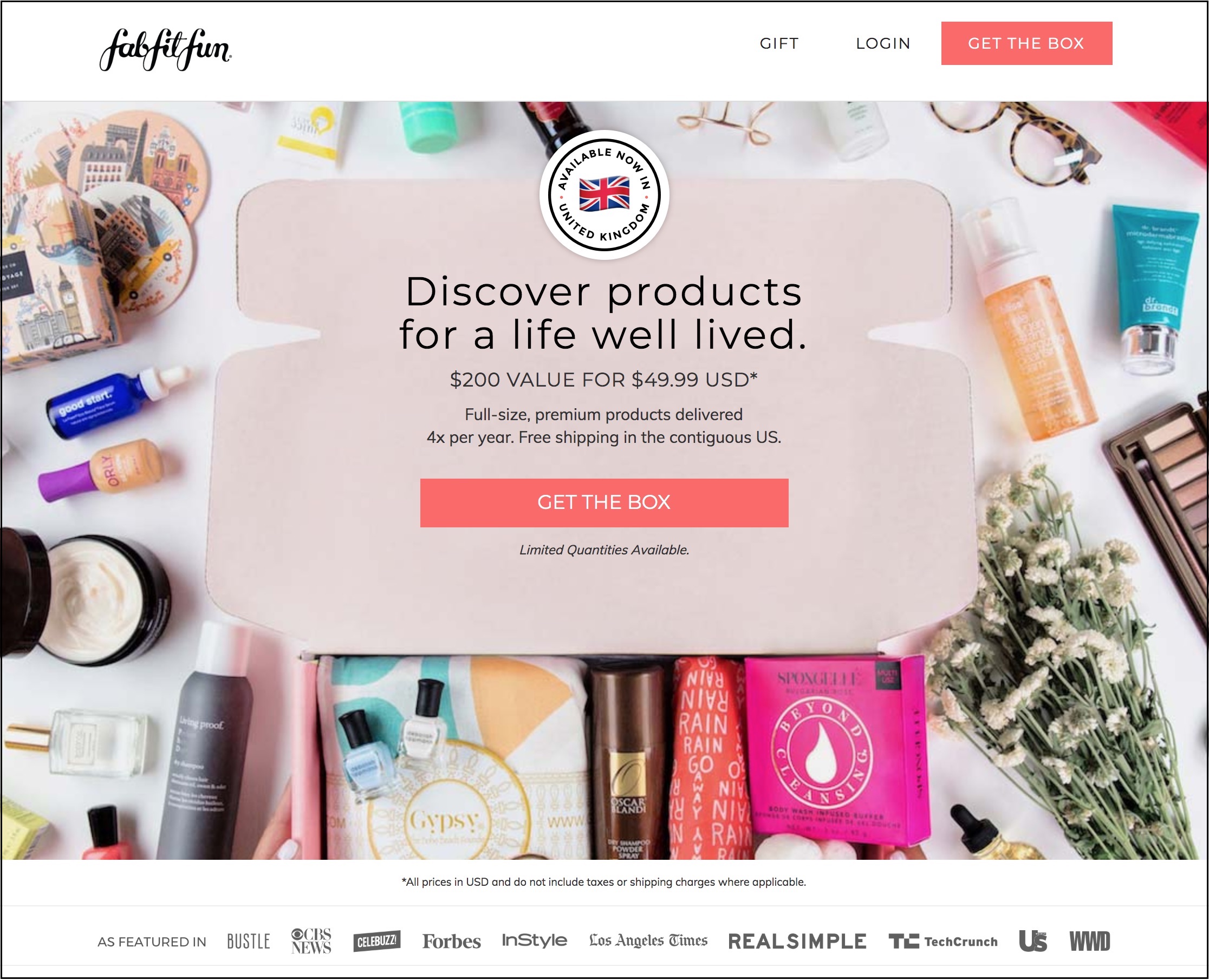
FabFitFun offers subscribers a seasonal curated box of lifestyle products each quarter. Source: FabFitFun
Let’s take a look at the partner marketing strategies behind their success.
A Company Built By Influencers
Founded in 2010 by Katie Rosen Kitchens, Daniel Broukhim, and Mike Broukhim, FabFitFun began as an online magazine and daily newsletter. The company found traction producing beauty, fashion, fitness, and wellness content, and grew a loyal newsletter following in partnership with Guiliana Rancic. (Michael credits much of the brand’s DNA to the, well, influence Guiliana had as the company’s first influencer partnership.) Even so, after two years the founders came to a conclusion shared by many media outlets at that time: they needed to evolve to survive.
The team decided to experiment with a new e-commerce model. Noting the growing market for curated subscription boxes, they planned their own: a quarterly offering of full-size products, catered to a general audience. The idea grew out of their experience running a media company — notably, the free perks that came with it. “Brands would send us products for editorial review and provide us with VIP gift bags at media events,” Daniel recalls. “Nobody was replicating that experience — of getting to try all these amazing products — for public consumption. We thought we could deliver that experience for our audience.”
Before going all in on the new strategy, FabFitFun tested an initial run of 2,000 boxes. They hoped to establish product-market fit. They sold out of boxes in two days.
As influencers themselves, the founders saw an opportunity: a business inspired by marketing to influencers, running on influencer marketing. With a strong value proposition, deep knowledge of their target audience, and a differentiated product offering, they got to work.
Goals: Customer Acquisition and Revenue Growth
For the first 2,000 boxes, FabFitFun’s “original [subscription] members came from the newsletter list because they saw us as a valuable source to come to for all things beauty, fashion, and fitness-related,” Kitchens says. To grow beyond that existing newsletter base, FabFitFun needed a partner marketing strategy designed specifically for customer acquisition and revenue growth. In addition to delivering results, it was important that this strategy protect the brand’s reputation as a trusted lifestyle community and content provider.
Enter Jolie Jankowitz, head of influencer marketing at FabFitFun. In spring 2014, she launched an influencer marketing program to address the goals above. To do it, she built a program supported by two driving factors: a performance marketing model, and authentic influencer partnerships.
Partner Portfolio: Authenticity + Influencers of All Kinds
FabFitFun’s strength has always been its ability to inspire trust and positivity in customers. To sell its subscription boxes, the company wanted to work with influencers who could do the same. To find these partners, and to protect the program against the risks of placing all her eggs in one partner type basket, Jankowitz sought to diversify in two ways: first, by the types of partners she worked with, and second, by the variety of partners within those types. Her strategic target partner list included an array of influencers (from celebrities to micro- and nano-influencers), content creators, community managers, and referral partners.
Ultimately, when deciding who the company should partner with, Jankowitz looked for one thing above all: authenticity.
“Although we consider following and engagement, it is not the deciding factor in which influencers we choose to partner with,” Jankowitz says. “Authenticity is the most important factor by far. We look for women who are relatable and have stories to tell, rather than influencers with unattainable, perfectly curated feeds.”
“We don’t just work with super high-end fashion Instagrammers or the popular beauty gurus on YouTube,” Kitchens echoes. “We really work with a wide variety of women that represent who our members are. Mom-trepreneurs, fitness influencers, and, yes, a lot of different reality stars, but we work with influencers of all different ages, ethnicities, and geographies. We believe our goal is to ensure that our members are being represented with the people we partner with.”
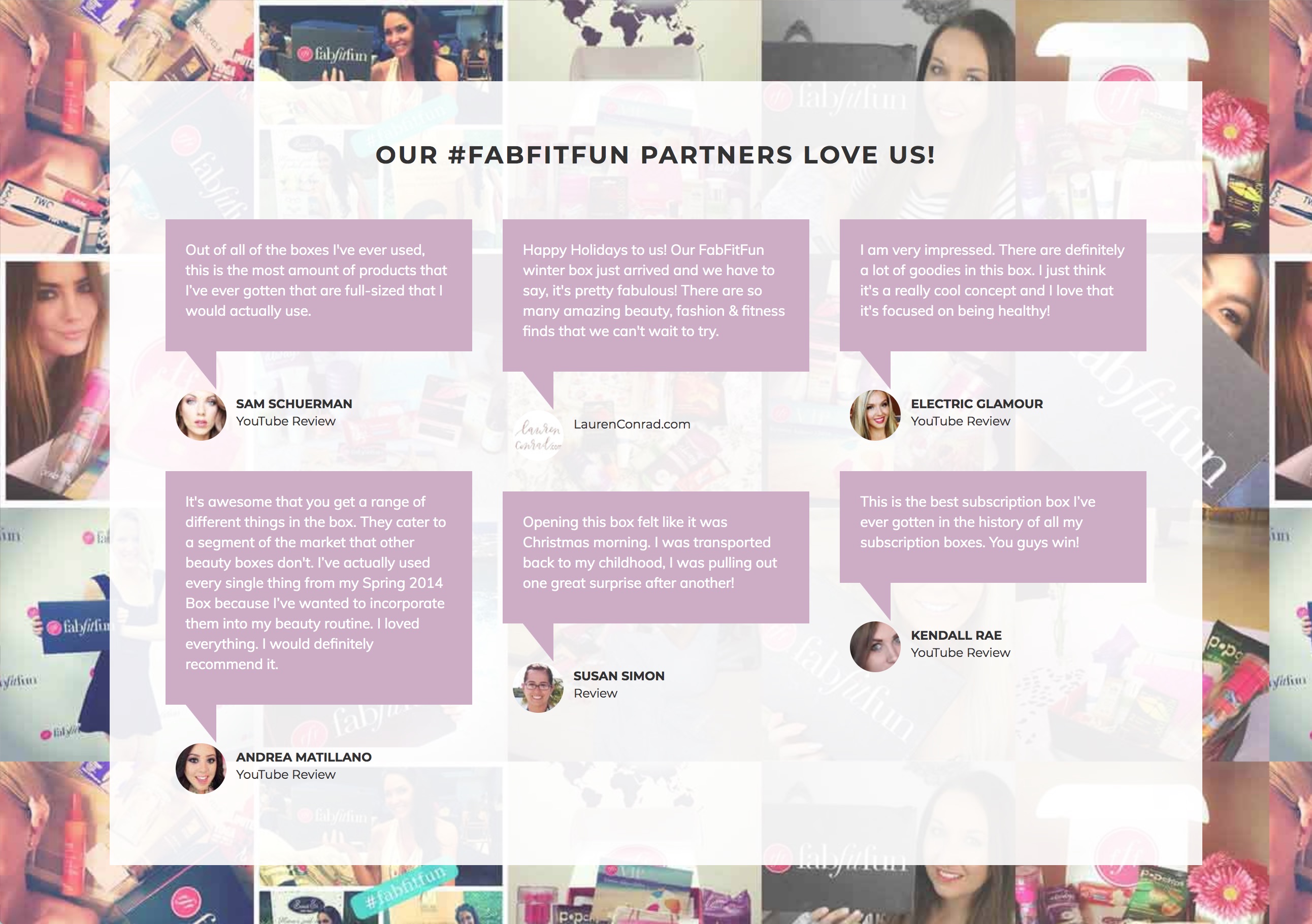
FabFitFun partners with a variety of influencers, content creators, and affiliates for their partner marketing program. Source: FabFitFun
This quest for authenticity is rooted in the company’s influencer DNA. It’s also out of respect for word-of-mouth marketing strategies. They trust influencers to know their audience; they know that user generated content can be a powerful tool for championing creativity and diversity. But the brand has only reached this point by listening, and putting a priority on customer interactions. (Kitchens herself says she is in the community 24/7, interacting with members “night and day.”)
There are also tangible business benefits to being obsessed with being genuine — better customer acquisition, for one. Michael explains:
“[W]e’ve decided from all of our practices to be extremely customer friendly and just make sure that everyone who interacts with us [FabFitFun] in any way, whether it’s with customer service or a cancel user experience or anything like that, is doing so in a seamless and positive way. I think what that’s done is just create a lot of positivity. Just a lot of ambassadorship around the brand. I think that’s at the core of what drives our entire customer acquisition engine.”
– Michael Broukhim, Co-Founder and Co-CEO, FabFitFun
By choosing to work with influencers who reflect the customer base and embody company values, FabFitFun has created a virtuous cycle of customer feedback and growth. For some, this cycle is what amounts to a self-powered partner marketing program. These partners help FabFitFun and brands that work with the company to engage customers in ways that feel both personalized and personal. As FabFitFun’s recent funding announcement states, “The company’s personalized connection with its community allows brands to better understand and interact with consumers – establishing a long-term relationship rather than simply a transaction.”
In addition to a diverse group of influencers and content creators, FabFitFun’s partner marketing strategy includes brand and product partners. These partners supply goods at or below production cost; some brands provide products for free in exchange for the exposure a subscription box offers. Others, including some consumer packaged goods companies, have partnered on paid campaigns. All of these partnerships enable FabFitFun to keep customer costs down and business revenue up.
Influencing Results This Year and Beyond
Following the launch of its subscription box business in 2013, FabFitFun has grown 300% year over year. The company now boasts more than 1 million subscribers, and is expanding into new areas, including augmented reality and live video.
But FabFitFun isn’t the only example of a company that found success by aligning the right goals and partnerships. Take T-Mobile, for instance. By working with a variety of business development partners through the T-Mobile Tuesdays app, the phone company guarantees something for every customer, and provides every partner with exposure to new potential audiences.
When choosing your own partner portfolio, remember the overall goals you want your program to achieve. Also take care to adjust your marketing strategy based on the type of partner you choose. Influencers, for example, are motivated by different things than coupon and deal partners. How you leverage those motivations can make all the difference. As Jankowitz says, “Sponsored content doesn’t have to lack authenticity, and when you give influencers freedom, you’ll see the return tenfold.” (We discuss this digital advertising trend here, and cover influencer motivations and more in our chapter on partner types in the Ultimate Guide.)
What are your biggest goals for your program? What are the biggest challenges for your partner marketing strategy? Tell us in the comments below!
Grab your copy of The Ultimate Guide to Partner Marketing here. Questions? Drop us a note at [email protected].
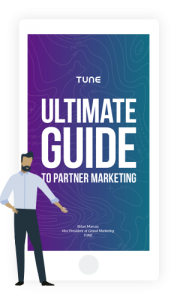
Follow our Ultimate Guide to Partner Marketing blog series to learn strategies for how to plan, build, and grow cross-channel affiliate, influencer, and partner marketing programs. For the rest of the series, check out:
- Part 1 – Planning Your Partner Program Strategy
- Part 2 – Determining Partner Payouts and Marketing Policies
- Part 3 – Recruiting and Onboarding Partners
- Part 4 – Communicating for Partner Compliance
- Part 5 – Managing Partner Offers
- Part 6 – Partner Payments
- Part 7 – Program Analysis and Optimization
Author
Becky is the Senior Content Marketing Manager at TUNE. Before TUNE, she handled content strategy and marketing communications at several tech startups in the Bay Area. Becky received her bachelor's degree in English from Wake Forest University. After a decade in San Francisco and Seattle, she has returned home to Charleston, SC, where you can find her strolling through Hampton Park with her pup and enjoying the simple things in life.

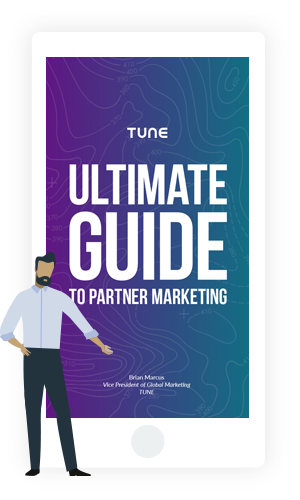
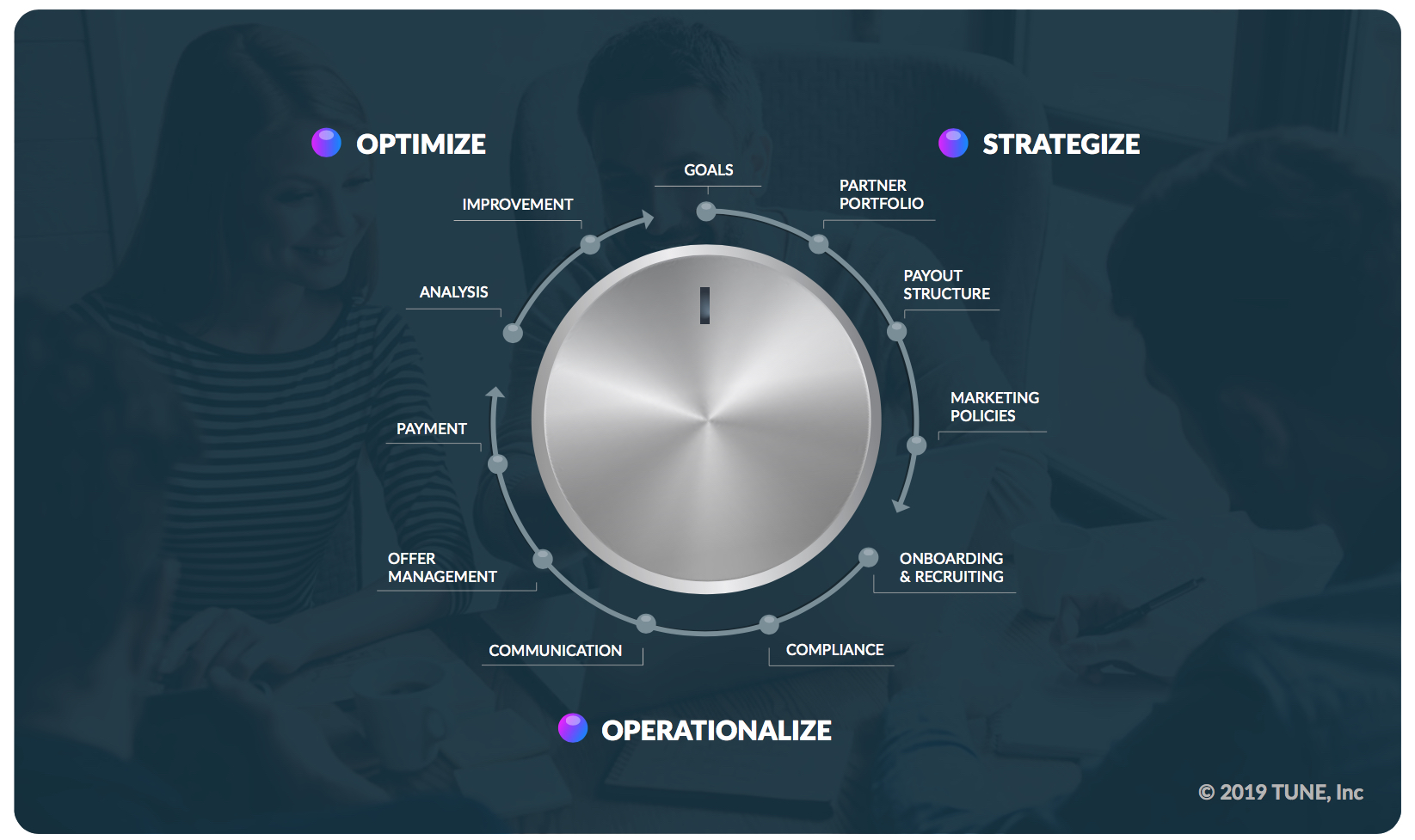


![Buy vs DIY: The Pros and Cons of Buying vs Developing Your Tracking Platform [Infographic]](https://www.tune.com/wp-content/uploads/2018/01/Blog-4-540x300.jpg)
Leave a Reply
You must be logged in to post a comment.